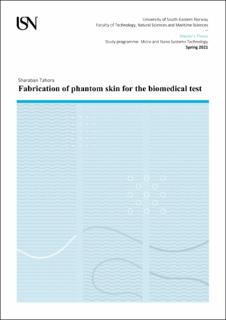Fabrication of phantom skin for the biomedical test
Abstract
Implantable biomedical devices (IMDs) have an enormous prospect in the medical sector. A phantom skin model with similar properties to human skin can be fabricated to analyze if the exchange of energy between the IMD and external devices can produce any effect on the skin of the patient. This analysis can provide numerous information before implanting the IMD in humans and animals.
This project aims to fabricate a phantom skin model with similar electrical and acoustic properties to human skin to test IMDs. The fabrication methodology is based on the agar/gelatin gel with other chemicals to replicate some properties of human skin, such as conductivity, speed of sound (SOS), and attenuation coefficient.
An agar-based gel with NaCl solution was prepared to replicate the electrical properties, which was validated with a conductivity meter probe. For the acoustic model of human skin, agar/gelatin powder was used to prepare the gel with other chemical substances. Among the others, bovine serum albumin (BSA), methanol, glutaraldehyde were expected to provide the best results. To compare the multilayer and homogeneous phantom models, both types of phantom skins were fabricated. Later the characterization of the acoustic properties was done with piezoelectric transducers in a water tank setup.
Due to the closure of the lab, all the experiments were not completed. Therefore, the electrical and acoustic properties in one single phantom model could not be achieved. Further experiments can be conducted to achieve this goal and to have improved received signals for calculating the speed of sound. Implantable biomedical devices (IMDs) have an enormous prospect in the medical sector. A phantom skin model with similar properties to human skin can be fabricated to analyze if the exchange of energy between the IMD and external devices can produce any effect on the skin of the patient. This analysis can provide numerous information before implanting the IMD in humans and animals.
This project aims to fabricate a phantom skin model with similar electrical and acoustic properties to human skin to test IMDs. The fabrication methodology is based on the agar/gelatin gel with other chemicals to replicate some properties of human skin, such as conductivity, speed of sound (SOS), and attenuation coefficient.
An agar-based gel with NaCl solution was prepared to replicate the electrical properties, which was validated with a conductivity meter probe. For the acoustic model of human skin, agar/gelatin powder was used to prepare the gel with other chemical substances. Among the others, bovine serum albumin (BSA), methanol, glutaraldehyde were expected to provide the best results. To compare the multilayer and homogeneous phantom models, both types of phantom skins were fabricated. Later the characterization of the acoustic properties was done with piezoelectric transducers in a water tank setup.
Due to the closure of the lab, all the experiments were not completed. Therefore, the electrical and acoustic properties in one single phantom model could not be achieved. Further experiments can be conducted to achieve this goal and to have improved received signals for calculating the speed of sound.
